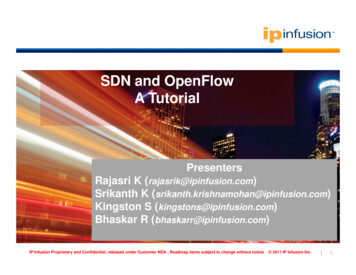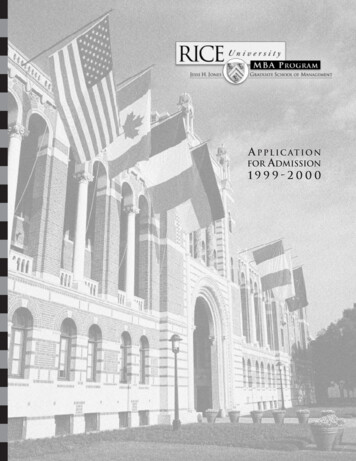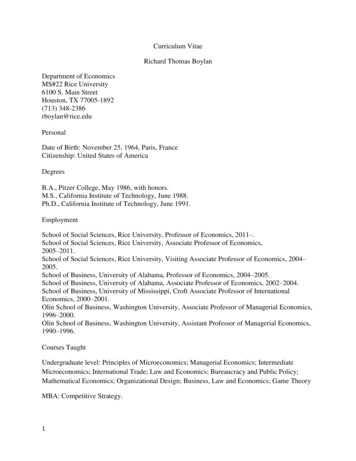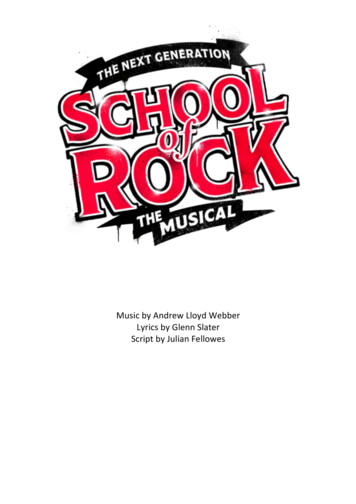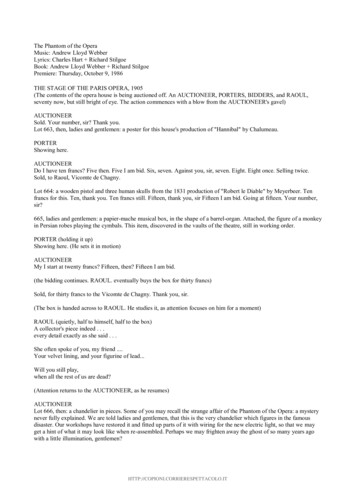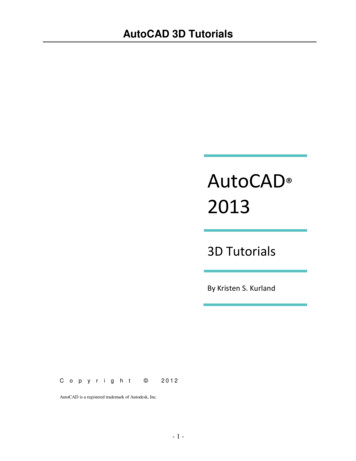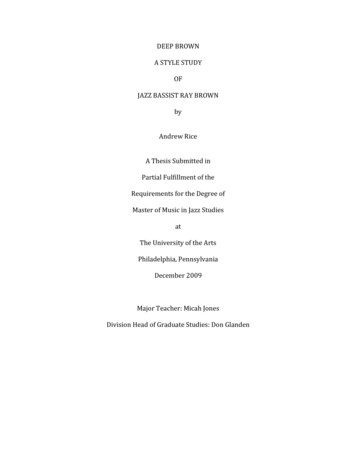
Transcription
DEEP BROWNA STYLE STUDYOFJAZZ BASSIST RAY BROWNbyAndrew RiceA Thesis Submitted inPartial Fulfillment of theRequirements for the Degree ofMaster of Music in Jazz StudiesatThe University of the ArtsPhiladelphia, PennsylvaniaDecember 2009Major Teacher: Micah JonesDivision Head of Graduate Studies: Don Glanden
2Table of ContentsIntroduction3Brown’s Timeline3Deep Brown4Rhythm Drops5Arpeggio Voicings10Other Common Patterns15Harmonic Superimposition17Two‐Feel19Phrasing20Double Stops ,Triple Stops, and Tenths21In Conclusion23
3IntroductionRay Brown’s signature style and mastery of his instrument set him apart as atrue individual jazz musician. Ray Brown’s time, feel, sound, and his profoundcontrol of his chosen instrument are all things that come up in writings about thebassist. My earliest mentors in Jazz always referred to him when trying to teach mehow to swing and drive a rhythm section.Brown’s TimelineRay Brown’s career started out when he began playing gigs on the bass thathe borrowed from his high school. After paying dues locally and graduating highschool, he hit the road with various dance bands. He eventually found his way toNew York City to try his luck in the jazz scene of the mid‐forties. He quickly landed agig with Dizzy Gillespie and then as the house bassist with the Jazz at thePhilharmonic concerts. This brought him into contact with Ella Fitzgerald, who hewould back up and eventually marry, manage, and amicicably divorce. ThroughJATP, he also met Oscar Peterson and they began playing as a duo. They would goon to play together for fifteen years in the Oscar Peterson trio. They recorded manyrecords and travelled the world out‐swinging big bands with their powerful trio. Healso published an instructional book, and became very active in teaching.After his tenure with Oscar Peterson, Ray moved to Los Angeles and hiscareer path changed from lots of jazz work to commercial studio work like movieand television soundtracks. He spent less time on the road and also delved into the
4business side of music, managing the Modern Jazz Quartet and Quincy Jones. He dida lot of work for Henry Mancini, got into composing, and taught classes at UCLA.He recorded many albums as a leader and co‐leader. Notably, he made a duoalbum with Duke Ellington and led his own trio. He also formed a band called TheL.A. Four and they would play a blend of jazz, Brazilian, and classical music. Thelatter part of his career found him mostly playing with his own trio and teachingmaster classes.Deep BrownThe main thing that stands out about Ray Brown is that he played the bass ona level that surpassed his instrument’s traditional role as timekeeper and root‐noteplayer. He displayed a depth that is seen in his rhythmic sophistication, strongharmonic knowledge, and motivic development. In addition to his sound and time‐feel, this depth is what defines Ray Brown as an important jazz bassist.He was on such a deep musical level that he improvised bass lines the way that amaster composer presents a motif and develops it, like a story unfolding over thecourse of a tune.Brown was very comfortable, technically, on his instrument, and also with allmanner of harmonic movement. There was a constant curiosity with Ray Brown.When on tour in a new city, he could be found studying with, or just talking aboutthe double bass with local symphony bassists (Lees.) Dizzy Gillespie said about theyoung Ray Brown that he was very inquisitive and always wanted to know aboutwhat Dizzy was doing, harmonically (Lees 19‐20.) This pursuance of furtherdevelopment continued into his tenure with The Oscar Peterson Trio when Peterson
5would ask Ray to play arrangements that were very challenging and he would pushhimself to get them right (Lees 19.) I feel that this curiosity and pursuance of newinformation is the main reason for his depth. It is a common characteristic in peopleof creative greatness. This paper is going to work from the inside out with theanalysis, starting from the simplest rhythmic motifs, moving on to his note choiceson a measure‐by‐measure basis, and then onto longer scalar and chromatic phrases.Rhythm DropsOne of the things about Ray Brown’s playing that is often mentioned whendiscussing what makes him so recognizable, is his aggressive sense of time. Namely,that he plays ahead of the beat, pushing the time. The use of rhythm drops in hisbass lines helps to give the music a feeling of forward momentum. In “Ray Brown’sBass Method,” there is a chapter on rhythm drops, where he introduces fourdifferent types of figures that can be used in walking bass lines. A rhythm drop is arhythmic variation of the standard quarter note walking bass line. He says in theintroduction: “my view is that “drops” should be played in holes, or used to give therhythm section a boost.”(Brown, p.63)The first of the four is a figure with an eighth note followed by a dottedquarter note. In the book, he provides the following exercise:In his own playing, he uses this particular rhythmic figure sparingly, likelybecause it puts an emphasis on the ‘and’ of the beat and would draw the listener’sattention away from the harmonic movement by accenting the off‐beat, which is not
6always appropriate. He advises at the beginning of this chapter: “Above all, don’tplay ‘drops’ just anywhere.” (Brown, 63) Brown primarily uses this particular figureat the end of a tune (example 1b), or in conjunction with a chromatic ascending linewhere a leap down is resolved by step up as in an appoggiatura (example 1c.)Example 1b: “Things ain’t what they used to be.” Duke Ellington/Ray Brown “This one’s for Blanton”Example 1c: “Night Train” The Oscar Peterson Trio “Night Train”This figure is also used in conjunction with chord anticipation when applied to beatfour:Example 1d: “F.S.R.” The Ray Brown Trio “Bam Bam Bam”Or as a way to keep the rhythm section moving forward as on beat two of the secondmeasure here:Example 1e: “Stella by Starlight” The Ray Brown Trio “Walk on”
7The next two rhythm drops are illustrated in the following excerpt from “RayBrown’s Bass Method.” The triplet figure will be called rhythm drop #2 and thedotted‐eighth sixteenth note figure, rhythm drop #3.Example 2a: exercise from page 70 of “Ray Brown’s Bass Method”Brown employs rhythm drop #2 on any of the four beats in a measure. Whenthe figure is descending, it consists mostly of chord tones and generally containsleaps:Example 2b: “Stella by Starlight” Ray Brown Trio “Walk on.”Example 2c: “Things Ain’t what they used to be.” Duke Ellington/Ray Brown “This one’s forBlanton.”When the rhythm drop #2 is ascending, it tends to be more scalar or chromatic:Example 2d: “How High the Moon” Oscar Peterson Trio “Live at the Stratford ShakespeareanFestival.”
8There are also instances, when playing in a 2‐beat feel, that Brown heavily employsrhythm drop 2, but not in the ways given before. Here, he uses the last two notes inthe triplet figure to include a drop in his lines.Example 2e: “Stella By Starlight” Ray Brown Trio “Walk On”Rhythm drop number 2 is the most common one that occurs and could benotated three different ways. It could be notated as two eighth notes or a tripletfigure with the first two notes tied together. Here it will be notated as it is in ‘TheBass Method.’ A dotted eighth note followed by a sixteenth note.Example 3a: “F.S.R.” Ray Brown Trio “Bam Bam Bam”Many times, this particular drop involves open strings, as on the first beat ofthe second measure of this example:Example 3b: “How High the Moon” Oscar Peterson Trio “Live at the Stratford Shakespeareanfestival.”Mostly, this is due to the fact that, technically, it makes sense. If a note is played onthe G‐string, it is fairly natural to use the D string in a rhythm drop because theplucking finger is in position to pull the D once the G has been pulled. In fact, most
9of the instances of drops in these transcriptions, even if they involve stoppedstrings, typically go from a high string to a low string.Example 3c: “Things Ain’t What they used to be” Duke Ellington/Ray Brown “This One’s ForBlanton.”It goes without saying that jazz music is not a strict art form, and so it goeswith the applications of these rhythm drops. Ray Brown definitely mixes andmatches all of these drops in many different ways. He often will play dropsconsecutively and of the same type:Example 4a: “How High the Moon” Oscar Peterson Trio “Live at the Stratford Shakespearean festival.”Example 4b: “Stella By Starlight” Ray Brown Trio “Walk On”Other times, he mixes different rhythm drops together in a measure (example 4c) orover the course of a few measures (example 4d)Example 4c: “Things Ain’t What they used to be” Duke Ellington/Ray Brown “This One’s ForBlanton.”
10Example 4d: “Things Ain’t What they used to be” Duke Ellington/Ray Brown “This One’s ForBlanton.”Arpeggio VoicingsIt’s necessary here to make a clarification on the use of an unorthodox use ofthe term ‘Voicings.’ This term is not typically used when referring to bass lines, butit is used here to describe the combination of notes, employed in a given measure,by a bass player in course of a line. In a standard swing feel, this will typically be afour‐note combination, with or without the addition of a rhythm drop. Just likepiano or guitar chord voicings, numbers will be used that correspond with the chordmembers to distinguish between the different voicings.The most common voicing in Ray Brown’s bass lines is the voicing 1‐7‐5‐1.This is a descending voicing beginning on an upper root and continuing down toeach next lower chord tone.Example 5a: “Stella By Starlight” Ray Brown Trio “Walk On”1751This voicing can easily be played in any position without any shifting, so that’sprobably why it is so prevalent. Variations of this voicing occur on the last beat ofthe measure, either by octave displacement or rhythm drops, which function as non‐harmonic tones, mostly. For instance, when a lower note is not available due to the
11range of the bass, the last note is played in the same octave as the first note in thevoicing.Example 5b: “Stella By Starlight” Ray Brown Trio “Walk On”1751Here is an example of an instance where the choice was made to play the note ‘E’one octave below the normal voicing.Example 5c: “Quiet Nights of Quiet Stars (Corcovado)” Oscar Peterson Trio “We Get Requests”1751Example 5d is an instance where the last note in the voicing was played an octavehigher to facilitate a drop using the open strings ‘G’ and ‘D.’Example 5d: “How High the Moon” Oscar Peterson Trio “Live at the Stratford Shakespearean festival.”1751Ray’s depth is expressed here in how he uses this simple chord voicing as a motifthrough a series of chords.Example 5e: “How High the Moon” Oscar Peterson Trio “Live at the Stratford Shakespearean festival.”175117511751
12Example 5f: “Quiet Nights of Quiet Stars (Corcovado)” Oscar Peterson Trio “We Get Requests”17511751The 1‐3‐5‐1 voicing Brown employs is used primarily as an ascendingpattern.Example 6a: “How High the Moon” Oscar Peterson Trio “Live at the Stratford Shakespearean festival.”1351Displacing the outer two notes by octaves creates a much less linear sound. In thefollowing example, the note ‘G’ is played open to facilitate a shift to a lower position.Example 6b: “How High the Moon” Oscar Peterson Trio “Live at the Stratford Shakespearean festival.”1351He uses drops with this voicing to move the music forward and also to create sometension in between the chord tones by including chromatic passing notes in thedrops.Example 6c: “Stella By Starlight” Ray Brown Trio “Walk On”1351
13Displaying his concept of the entire musical picture, Brown applies this voicing toseveral measures in a row, even overlapping the last two voicings.Example 6d: “Prelude Opus 28 No. 4/How Insensitive” L.A. Four “The L.A. Four Scores!”1351135 1351In most occurrences of the 1‐5‐3‐1 voicing, it is primarily a descendingpattern.Example 7a: “Quiet Nights of Quiet Stars (Corcovado)” Oscar Peterson Trio “We Get Requests”1531Other times, it does not necessarily ascend or descend, but remains in the sameplace, as the pattern ends on the same note on which it started.Example 7b: “Stella By Starlight” Ray Brown Trio “Walk On”1531The following example shows an instance where both of those variations of thevoicing are played in a row with two different drops.
14Example 7c: “How High the Moon” Oscar Peterson Trio “Live at the Stratford Shakespeareanfestival.”15311531In “F.S.R.(for Sonny Rollins)” Ray plays the 1‐5‐3‐1 pattern almost everysingle time an Eb7 chord appears for a whole measure, with one variation(example7d) where he displaces the first note up an octave from the typical pattern(example7e) he uses in the rest of the tune.Example 7d: “F.S.R.” Ray Brown Trio “Bam Bam Bam”1531Example 7e: “F.S.R.” Ray Brown Trio “Bam Bam Bam”1531Other common patternsThe intention of the individual player aside, a bass line only needs to followone simple guideline in order to strongly spell out the chord changes: Always play achord tone on the strong harmonic beats of the measure, beat one and beat three.This is the bare minimum and Ray Brown, of course, took the role a little bit deeper.He played many different patterns (voicings) to outline chords that are a little more
15linear and melodic than the arpeggios of the last section. In addition to chord tones,these patterns include scale notes and chromatic passing notes.In music theory I, every music student learns, when learning about goodmelodies, that a leap (span an interval larger than a major 2nd) must always beresolved by step. Ray Brown often phrases his bass lines in this very fashion.Typically you will see an ascending scalar or chromatic pattern followed by adescending pattern containing leaps or more often than not, an arpeggiation of somesort. Also, you will find combinations of the scalar and chromatic patterns creatinga longer, slower line that creates the effect of,
Ray Brown’s signature style and mastery of his instrument set him apart as a true individual jazz musician. Ray Brown’s time, feel, sound, and his profound control of his chosen instrument are all things that come up in writings about the bassist. My earliest mentors in


